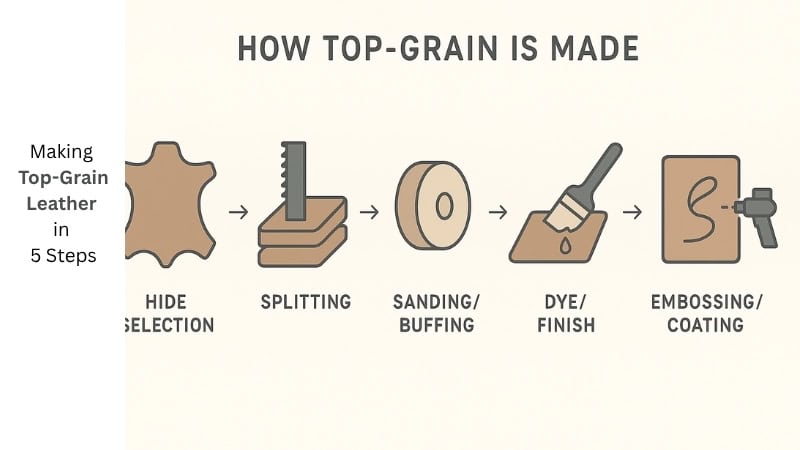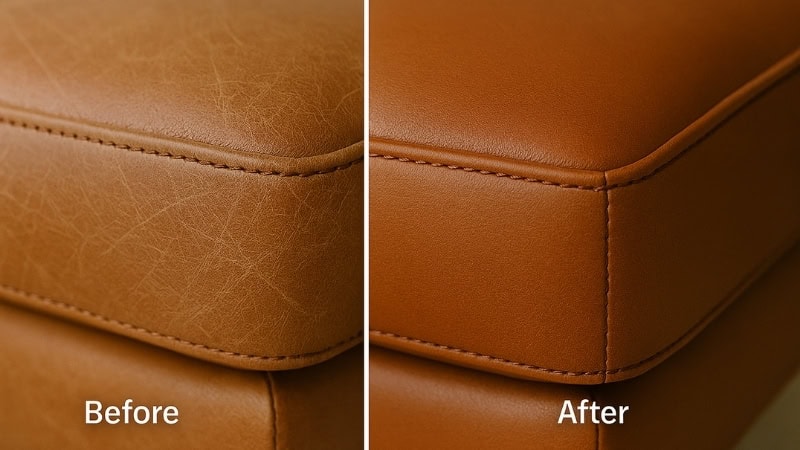If you’ve ever shopped for a leather bag, jacket, sofa, or wallet, you’ve probably seen the term top-grain leather thrown around like it’s a badge of honor.
Top-grain leather is a high—quality, yet one of the most misunderstood and widely used, leather types in the world.
In this guide, we’ll break it down without the fluff. You’ll learn what it is, how it’s made, how to tell it apart from other leathers, and whether it’s the right choice for you.
What Does “Top-Grain Leather” Really Mean?
Before we discuss the pros, cons, and uses, we need to clarify the definition. Too many people (and brands) throw the term around without understanding what it actually means.
Top-grain leather comes from the uppermost layer of the hide — the same layer used for full-grain. The key difference?
In top-grain, the surface has been lightly sanded, buffed, or shaved to remove visible scars, insect bites, wrinkles, or branding marks that occurred during the animal’s life.
This process leaves you with leather that’s:
- Smoother than full-grain.
- More consistent in color and texture.
- Easier to finish with dyes, coatings, or embossing patterns.
It’s still genuine, natural leather — just a little more refined for visual perfection. Think of it like editing a photo: you keep most of the details, but you retouch the blemishes.
How Top-Grain Leather Is Made
Understanding how top-grain leather is made will not only help you identify it but also explain why it feels, looks, and ages differently than other leathers. The process is careful, deliberate, and combines traditional craftsmanship with modern finishing techniques.

Here’s a detailed look at the journey from raw hide to finished product:
- Hide Selection
- Tanners choose hides that are free from deep gouges or extreme blemishes.
- Imperfections are acceptable because they can be corrected later, but fewer defects mean less sanding is needed.
- Splitting
- The hide is split horizontally into layers.
- The top layer — the one with the tightest, strongest grain structure — becomes top-grain. The bottom layers may be used for split leather, suede, or bonded leather.
- Sanding/Buffing
- This is the step that defines top-grain.
- The grain surface is lightly abraded to remove scars, wrinkles, and branding marks.
- The result is a more even texture that accepts finishes more consistently.
- Dyeing & Finishing
- Dyes are applied — often pigment dyes for a uniform look, though aniline or semi-aniline finishes may be used for higher-end pieces.
- A protective topcoat may be added to resist stains and water.
- Optional Embossing or Coating
- If desired, a grain pattern is pressed into the surface to mimic full-grain’s natural look or to create a decorative texture.
By the time this process is complete, the leather is durable, attractive, and ready to be turned into everything from handbags to car seats.
Top-Grain vs Full-Grain vs Corrected Grain
A lot of confusion comes from the fact that top-grain sounds like it should be the absolute best. In reality, it’s more about different priorities.
Before you decide, here’s how the main types compare:
| Leather Type | Surface Treatment | Durability | Appearance | Price |
| Full-Grain | None — natural grain intact | Maximum | Natural, unique, develops patina | $$$$ |
| Top-Grain | Light sanding & finish | Very High | Smooth, uniform | $$$ |
| Corrected Grain | Heavy sanding + embossing | High | Very uniform, sometimes synthetic look | $$ |
| “Genuine” | Lower layers, reconstituted | Medium–Low | Varies widely | $ |
Key takeaway:
- Full-grain is for purists who want the hide’s story visible in every scar and mark.
- Top-grain is for those who want a clean, refined look with easier maintenance.
- Corrected grain is for heavy-duty use where appearance uniformity is more important than natural character.
Pros & Cons of Top-Grain Leather
Like anything in life, top-grain leather isn’t perfect — and that’s okay. The key is knowing what it does brilliantly and where it falls short. With this clarity, you can decide whether it’s the right fit for your lifestyle and expectations.
Advantages:
- Uniform look — No distracting blemishes or scars.
- Easier maintenance — Stain resistance is often built-in.
- High durability — While not quite as strong as untouched full-grain, it’s still incredibly tough.
- More affordable — Usually cheaper than full-grain while offering many of the same benefits.
Drawbacks:
- Slightly less strong — Sanding removes some of the tightest fibers at the very surface.
- Less patina — It won’t develop the same rich, aged look over decades.
- Potentially thinner — Some top-grain leathers are split thinner for flexibility, which can reduce longevity if too thin.
Recommended Read: Who Makes the Best Leather Furniture in Canada? – Top Picks
Where You’ll See Top-Grain Leather in Real Life
From the couch in your living room to the seats in your car, it’s often closer than you think. Top-grain leather is everywhere — from your living room to your wardrobe to your daily commute. Let’s look at where it shows up and why those industries love using it.
Common products:
- Furniture: Sofas, loveseats, recliners — especially in mid- to high-end ranges.
- Bags & Wallets: Durable enough for daily use without showing heavy wear too soon.
- Jackets: Smooth, polished finish works for dressy styles.
- Car Interiors: Luxury vehicles often use top-grain for seat covers because it balances softness with stain resistance.
Manufacturers often choose top-grain because it gives them a predictable, attractive surface to work with while still delivering genuine leather’s strength.
How Durable Is Top-Grain Leather?
Durability depends on three main things – tanning method, thickness, and care. This is the reason people choose leather in the first place — but it’s not the same across all types.
Top-grain balances toughness with a polished finish, but its lifespan depends on how it’s made and how you treat it. Let’s break down what you can expect from it over the years.
Average lifespan by product:
- Furniture: 10–15 years with regular cleaning and conditioning.
- Bags/Wallets: 5–10 years, often longer for lighter use.
- Jackets: Easily 10+ years with seasonal care.
If treated right, top-grain leather can easily outlast many synthetic materials — but it won’t take as much abuse as heavy full-grain gear without showing signs of wear.
How to Identify Top-Grain Leather
It’s one thing to know what top-grain leather is — it’s another to recognize it in the wild. Not all leather is created equal, and labels don’t always tell the whole truth.
Learning to identify top-grain by sight, touch, and smell can help you avoid knock-offs or lower-grade substitutes. Spotting top-grain leather isn’t rocket science — but it does take a keen eye and a bit of feel.
Here’s what to look — and feel — for when shopping.
Look for:
- Even grain pattern with minimal natural blemishes.
- Smooth, sometimes coated surface.
- Consistent color throughout.
Touch for:
- Slight firmness compared to full-grain.
- Less “texture” from pores and scars.
Smell for:
- Rich leather scent, though sometimes fainter if heavily finished.
If a product looks too perfect, it’s likely top-grain or corrected grain rather than untouched full-grain.
Caring for Top-Grain Leather
Once you own it, the next challenge is keeping it looking great for years. The good news is that top-grain is easier to care for than you might think — but it still needs some love. Forgiving, but that doesn’t mean you can ignore it.
Let’s go over simple habits that protect your investment.
Routine care:
- Dust or vacuum upholstery every week.
- Wipe bags and jackets with a damp microfiber cloth to remove dirt.
Recommended Read: Best Way to Clean Leather: The Ultimate Leather Cleaning Guide
Deep cleaning:
- Use a pH-balanced leather cleaner — avoid dish soap or alcohol wipes.
- Clean in small sections to prevent water spotting.
Conditioning:
- Apply leather conditioner every 6–12 months.
- Use sparingly — too much conditioner can make leather feel greasy or clog the surface.
Repair & Restoration
Even the toughest leather isn’t immune to life’s bumps and scrapes. The beauty of top-grain is that, with the right approach, many imperfections can be reversed.
The good news: scratches and scuffs are fixable. The better news: top-grain’s finish can often be recolored entirely for a fresh look. Here’s how to bring it back to life, whether you’re doing it yourself or calling in the pros.
DIY fixes:
- Minor scratches can be blended with leather conditioner or repair cream.
- Small stains can be spot-cleaned with mild cleaner.
Pro fixes:
- Color restoration for faded areas.
- Patch repairs for small tears.
Avoid trying to repair deep cracks yourself — that’s where pros earn their fee.
Why Top-Grain Leather Deserves Your Attention
Top-grain leather strikes the perfect balance between beauty, durability, and practicality. It offers a refined look without sacrificing strength, making it a smart choice for everyday leather goods. Knowing what sets it apart helps you invest confidently in quality that lasts and ages gracefully.



